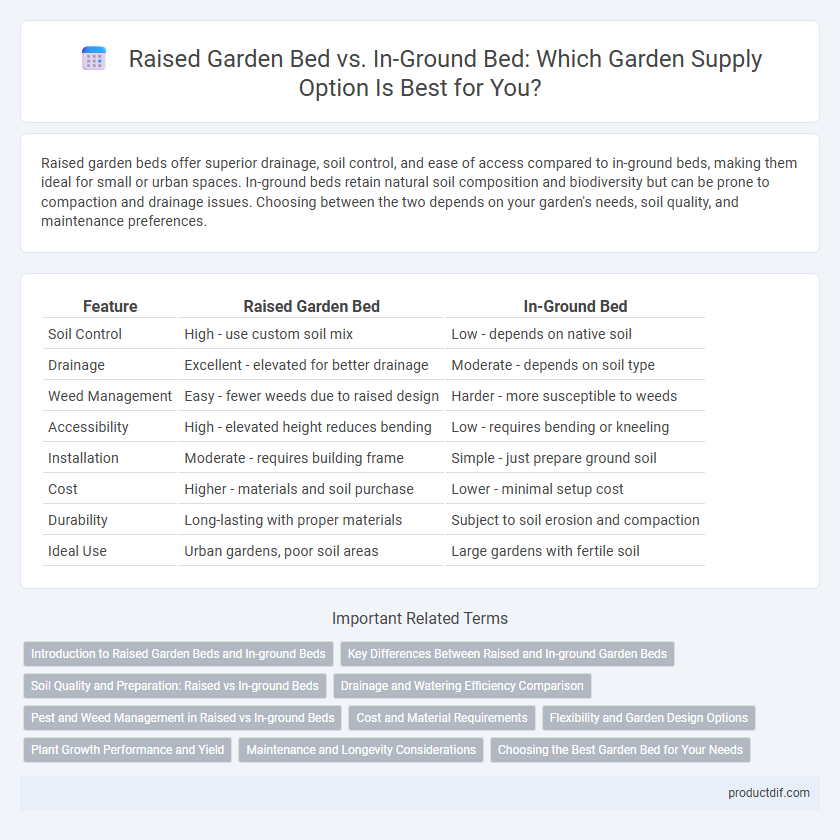Raised garden beds offer superior drainage, soil control, and ease of access compared to in-ground beds, making them ideal for small or urban spaces. In-ground beds retain natural soil composition and biodiversity but can be prone to compaction and drainage issues. Choosing between the two depends on your garden's needs, soil quality, and maintenance preferences.
Table of Comparison
| Feature | Raised Garden Bed | In-Ground Bed |
|---|---|---|
| Soil Control | High - use custom soil mix | Low - depends on native soil |
| Drainage | Excellent - elevated for better drainage | Moderate - depends on soil type |
| Weed Management | Easy - fewer weeds due to raised design | Harder - more susceptible to weeds |
| Accessibility | High - elevated height reduces bending | Low - requires bending or kneeling |
| Installation | Moderate - requires building frame | Simple - just prepare ground soil |
| Cost | Higher - materials and soil purchase | Lower - minimal setup cost |
| Durability | Long-lasting with proper materials | Subject to soil erosion and compaction |
| Ideal Use | Urban gardens, poor soil areas | Large gardens with fertile soil |
Introduction to Raised Garden Beds and In-ground Beds
Raised garden beds offer improved soil drainage, easier access for planting and maintenance, and better control over soil quality compared to in-ground beds. In-ground beds are traditional garden spaces directly planted into native soil, which can be beneficial for deep root growth but may face challenges such as soil compaction and poor drainage. Understanding the differences in soil conditions, accessibility, and pest control helps gardeners choose the optimal bed type for their specific cultivation needs.
Key Differences Between Raised and In-ground Garden Beds
Raised garden beds offer superior soil drainage and improved root aeration compared to in-ground beds, making them ideal for areas with poor soil quality or compacted earth. They also provide better weed control and easier access for planting and maintenance, reducing strain on the gardener's back and knees. In contrast, in-ground beds allow for deeper root growth and generally require less initial setup cost, but may suffer more from soil erosion and drainage issues depending on local conditions.
Soil Quality and Preparation: Raised vs In-ground Beds
Raised garden beds offer superior soil quality control by allowing gardeners to fill them with nutrient-rich, well-draining soil tailored to specific plant needs, reducing soil compaction and improving root development. In-ground beds rely on existing soil conditions, which may require extensive amendments, testing, and preparation to address poor drainage, low fertility, or contamination issues. Raised beds also warm up faster in spring, enhancing soil microbial activity and extending the growing season compared to traditional in-ground planting.
Drainage and Watering Efficiency Comparison
Raised garden beds offer superior drainage by elevating soil above ground level, preventing waterlogging and promoting oxygen flow to plant roots. In-ground beds may suffer from poor drainage in compacted or clay-heavy soil, leading to water retention and potential root rot. Watering efficiency is enhanced in raised beds as water can be targeted directly to the root zone, reducing runoff and evaporation compared to in-ground beds.
Pest and Weed Management in Raised vs In-ground Beds
Raised garden beds offer superior pest and weed management due to improved soil drainage and controlled soil composition, which reduces weed seed infiltration and deters burrowing pests. In-ground beds often face higher weed pressure from surrounding soil seed banks and are more susceptible to underground pests like root maggots and cutworms. Effective use of physical barriers, organic mulch, and integrated pest management strategies further enhances pest and weed control in raised beds compared to traditional in-ground gardening.
Cost and Material Requirements
Raised garden beds generally require upfront investment in materials such as wood, metal, or composite, with costs ranging from $50 to $300 depending on size and quality, while in-ground beds mainly incur soil amendments and labor costs, making them initially cheaper. Raised beds often need quality soil mix and possible irrigation installation, whereas in-ground beds utilize existing soil but may require significant soil improvement to ensure plant health. Material durability in raised beds can reduce long-term maintenance expenses compared to frequent soil replenishment and weed control necessary for in-ground beds.
Flexibility and Garden Design Options
Raised garden beds offer greater flexibility in garden design, allowing for customized shapes, sizes, and easy soil control tailored to specific plant needs. In-ground beds are limited by existing soil conditions and landscape, restricting design variations and potentially requiring more extensive soil amendments. Elevated options facilitate better drainage and accessibility, making them ideal for intricate layouts and urban gardening spaces.
Plant Growth Performance and Yield
Raised garden beds provide superior soil drainage and aeration, promoting healthier root development and enhanced nutrient uptake, which directly boosts plant growth performance. In-ground beds often face soil compaction and poor drainage issues, potentially restricting root expansion and limiting overall yield. Studies indicate raised beds can increase vegetable yield by up to 30% compared to traditional in-ground planting due to optimized soil conditions and reduced pest incidence.
Maintenance and Longevity Considerations
Raised garden beds offer easier maintenance due to improved soil drainage and reduced weed growth, extending plant health and bed longevity. In-ground beds may require more frequent soil amendments and weed control but benefit from natural soil ecosystems that support long-term fertility. Properly constructed raised beds with durable materials can last over a decade, whereas in-ground beds depend heavily on soil management for sustained productivity.
Choosing the Best Garden Bed for Your Needs
Raised garden beds offer improved soil drainage and better pest control, making them ideal for gardeners with poor or compacted soil. In-ground beds provide natural soil ecosystems and are generally more cost-effective, suitable for those with fertile, well-drained land. Selecting the best garden bed depends on factors like soil quality, budget, and desired maintenance level.
Raised Garden Bed vs In-ground Bed Infographic

 productdif.com
productdif.com